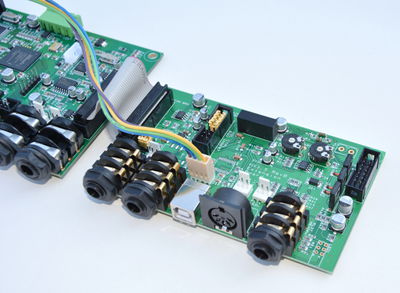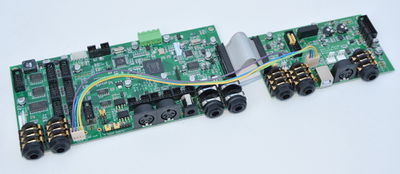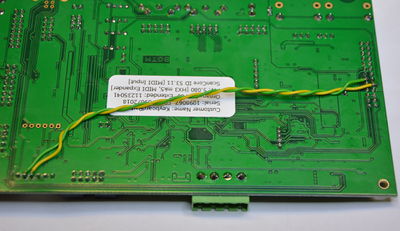HX3.5 Extension Board: Unterschied zwischen den Versionen
Bovist (Diskussion | Beiträge) KKeine Bearbeitungszusammenfassung |
|||
| (5 dazwischenliegende Versionen von einem anderen Benutzer werden nicht angezeigt) | |||
| Zeile 1: | Zeile 1: | ||
[[Datei:Hx35_extension_1.JPG|400px|thumb|right|'''HX3.5 Extension Board | [[Datei:Hx35_extension_1.JPG|400px|thumb|right|'''HX3.5 Extension Board connected to HX3.5 Mainboard''']] | ||
== | ==Preface== | ||
An updated HX3.5 Extension Board is available for Leslie and headphones connection. It carries a Leslie control and preamp circuit with separate Audio DAC, two 1/4" jacks for either audio (plain organ and pedal bass) or sustain and sostenuto pedals (selectable by jumpers) and an headphone amp. However, with some restrictions, you may use the old Extension Board mk3/mk4 for HX3.5 mainboard as well (see below). | |||
==HX3.5 Extension Board== | ==HX3.5 Extension Board== | ||
An updated HX3.5 Extension Board is available for Leslie and headphones connection. It carries a Leslie control and preamp circuit with separate Audio DAC, two 1/4" jacks for either audio (plain organ and pedal bass) or sustain and sostenuto switches (selectable by jumpers) and a headphone amp. It also provides an USB socket which is routed-through to HX3.5 mainboard (no USB socket installed on mainboard). | |||
===Installation=== | ===Installation=== | ||
The extension board for HX3.5 mainboards adds two additional audio outputs, Leslie(R) control and preamplifier for 9- and 11-pin Leslies, headphone jack, USB interface for MIDI over USB to your HX3 mainboard. It also adds a MIDI OUT, so that the HX3.5 board may be jumpered for two MIDI inputs. | |||
The extension board connects to HX3 mainboard by 26-pin header '''PL33''' and flat ribbon cable. Length of cable must not exceed 15 cm (6") as high-frequency digital signals are transmitted. For additional audio outputs, the extension board provides a second D/A converter. Outputs carry plain organ audio and bass pedal signal as they are routed to the Leslie connector. There is no reverb added. | |||
HX3 extension board brings its own power supply for Leslie preamp (DC/DC converter). Normally, '''PL30''' may be left open. If noise appears on Leslie audio, connect '''PL30''' to common +5V supply of HX3 (green header). | |||
=== | ===1/4" Jack Jumpers=== | ||
Two 1/4" jacks may either be used as audio outputs (factory default) or Sostenuto/Sustain footswitch inputs (momentary switches). Set jumpers JP1 and JP2 to 1-2 (facing towards JP lettering) to obtain switch inputs. Set jumpers JP1 and JP2 to 2-3 (facing towards 1/4" jacks)) to obtain audio output (Pedal Bass, organ main output; no reverb, no speaker simulation). | |||
===Potentiometer | ===Potentiometer Inserts=== | ||
A 16-pin header '''PL32''' provides send/return of Leslie and headphone signals to insert potentiometers (any 10k to 47k audio taper pot will do) or effects like 3-band equalizer. '''If no pots or effects are inserted, pins 1-2, 3-4, 5-6 and 7-8 must be bridged by jumpers.''' The connector also provides symmetrical 12V power supply for audio preamp circuits. | |||
{| border="1" cellpadding="8" cellspacing="0" | {| border="1" cellpadding="8" cellspacing="0" | ||
| Zeile 31: | Zeile 31: | ||
|Pin 1 | |Pin 1 | ||
|headphone signal left to pot | |headphone signal (rotary sim left out) to pot | ||
|- | |- | ||
|Pin 2 | |Pin 2 | ||
|headphone signal left from pot wiper | |headphone amp input signal (left) from pot wiper | ||
|- | |- | ||
|Pin 3 | |Pin 3 | ||
|headphone signal right to pot | |headphone signal (rotary sim right out) to pot | ||
|- | |- | ||
|Pin 4 | |Pin 4 | ||
|headphone signal right from pot wiper | |headphone amp input signal (right) from pot wiper | ||
|- | |- | ||
|Pin 5 | |Pin 5 | ||
| | |Plain organ signal to pot or effect | ||
|- | |- | ||
|Pin 6 | |Pin 6 | ||
| | |Leslie Rotary signal from pot wiper or effect | ||
|- | |- | ||
|Pin 7 | |Pin 7 | ||
| | |Bass/Pedal signal to pot or effect | ||
|- | |- | ||
|Pin 8 | |Pin 8 | ||
| | |Leslie Bass/Stationary signal from pot wiper or effect | ||
|- | |- | ||
| Zeile 78: | Zeile 78: | ||
|- | |- | ||
|} | |} | ||
<br> | |||
===Leslie Connection=== | ===Leslie Connection=== | ||
'''PL31''' | '''PL31''' carries complete 11-pin Leslie(R) control signals (power, slow/fast, audio signals organ and bass pedals). It connects to 11-pin Amphenol jack one-on-one, pins 12 to 14 of PL31 remain open. For connection of 9-pin Leslies, mind the different pinout. 6-pin Leslies (122/147) need an additional interface/relay circuit; please ask an experienced Hammond tech. | ||
Trim pots '''R8''' (stationary channel) and '''R9''' (rotary channel) on HX3.5 extension board may be adjusted to required Leslie output level (set to mid position as default). | |||
{| border="1" cellpadding="8" cellspacing="0" | {| border="1" cellpadding="8" cellspacing="0" | ||
|'''PL31''' | |'''PL31''' | ||
|''' | |'''Connection to 11 pin Leslie''' | ||
|- | |- | ||
|Pin 1 | |Pin 1 | ||
| Zeile 121: | Zeile 122: | ||
[[Datei:Hx35_extension_2.JPG|400px|thumb|right|'''HX3.5 Extension Board USB wiring by 4-wire cable (supplied). Note: Cable colors may be different.''']] | [[Datei:Hx35_extension_2.JPG|400px|thumb|right|'''HX3.5 Extension Board USB wiring by 4-wire cable (supplied). Note: Cable colors may be different.''']] | ||
USB interfaces to HX3.5 DSP as "MIDI over USB" only. To use the USB jack, install 4-wire cable (supplied) from Extension Board header PL42 to HX3.5 mainboard PL32. Omit installation of PL3 on HX3.5 mainboard (both connectors are wired in parallel). Connect a USB A/B cable to your PC; it should register as a standard USB MIDI interface. In some cases, a USB hub can disturb communication. In this case, connect HX3.5 USB directly to your PC. | |||
''' | '''Please note: If USB MIDI is being used, the secondary MIDI IN2 input on HX3.5 mainboard may not be used simultaneously'''. | ||
MIDI OUT | MIDI OUT on extension board is always an output, independant of PL18 jumper setting on HX3.5 mainboard. | ||
=== | ===Output Level for 147 type Leslies=== | ||
Output level of the Leslie output pins is not sufficient for old tube Leslies. Bridge R1 and R2 on HX3 Extension board with two additional 22kOhms SMD resistors (size 0805) to obtain doubled output level. Please note that 147 Leslies need a relais for SLOW/FAST switching. Relais coil may be driven from FAST motor control output of extension board. | |||
==HX3.4 Extension Board ( | ==HX3.4 Extension Board (discontinued)== | ||
[[Datei:Hx35_old_ext1.JPG|400px|thumb|right|''' | [[Datei:Hx35_old_ext1.JPG|400px|thumb|right|'''Additional wires required to use HX3.5 with old HX3 mk3/mk4 Extension Board USB port''']] | ||
Old Extension Board for '''HX3.4 (mk3/mk4)''' may be used with HX3.5 mainboard with some modifications. '''Remove R17 and R25''' (22k SMD, near PL33) from HX3.4 Extension board, otherwise a DC offset will occur on PEDAL BASS output. | |||
The USB port on old Extension board can be used as a remote control port; this requires '''two wires''' to be soldered from Extension Board connector to serial port on back of HX3.5 mainboard. Without these wires, the USB port on Extension Board is useless. Route one wire from PL1 pin 10 to PL19 pin 4 and one wire from PL1 pin 11 to PL19 pin 5 (see pictures). | |||
Please note: Even with HX3.5 mainboard, USB socket on old Extension Board is solely to be used for parameter tweaking with HX3.5 Editor. The connection is made via FTDI. '''DSP updates and MIDI over USB are not supported'''. For best results, use HX3.5 Extension board as described above. See page [[HX3 Extension Board Installation]] for details on old Extension Board. | |||
Therefore, you may use USB port on HX3.5 mainboard as "MIDI over USB" and USB remote control port (for HX3.5 Editor) on old Extension board simultaneously. | |||
Aktuelle Version vom 18. September 2023, 11:38 Uhr
Preface
An updated HX3.5 Extension Board is available for Leslie and headphones connection. It carries a Leslie control and preamp circuit with separate Audio DAC, two 1/4" jacks for either audio (plain organ and pedal bass) or sustain and sostenuto pedals (selectable by jumpers) and an headphone amp. However, with some restrictions, you may use the old Extension Board mk3/mk4 for HX3.5 mainboard as well (see below).
HX3.5 Extension Board
An updated HX3.5 Extension Board is available for Leslie and headphones connection. It carries a Leslie control and preamp circuit with separate Audio DAC, two 1/4" jacks for either audio (plain organ and pedal bass) or sustain and sostenuto switches (selectable by jumpers) and a headphone amp. It also provides an USB socket which is routed-through to HX3.5 mainboard (no USB socket installed on mainboard).
Installation
The extension board for HX3.5 mainboards adds two additional audio outputs, Leslie(R) control and preamplifier for 9- and 11-pin Leslies, headphone jack, USB interface for MIDI over USB to your HX3 mainboard. It also adds a MIDI OUT, so that the HX3.5 board may be jumpered for two MIDI inputs.
The extension board connects to HX3 mainboard by 26-pin header PL33 and flat ribbon cable. Length of cable must not exceed 15 cm (6") as high-frequency digital signals are transmitted. For additional audio outputs, the extension board provides a second D/A converter. Outputs carry plain organ audio and bass pedal signal as they are routed to the Leslie connector. There is no reverb added.
HX3 extension board brings its own power supply for Leslie preamp (DC/DC converter). Normally, PL30 may be left open. If noise appears on Leslie audio, connect PL30 to common +5V supply of HX3 (green header).
1/4" Jack Jumpers
Two 1/4" jacks may either be used as audio outputs (factory default) or Sostenuto/Sustain footswitch inputs (momentary switches). Set jumpers JP1 and JP2 to 1-2 (facing towards JP lettering) to obtain switch inputs. Set jumpers JP1 and JP2 to 2-3 (facing towards 1/4" jacks)) to obtain audio output (Pedal Bass, organ main output; no reverb, no speaker simulation).
Potentiometer Inserts
A 16-pin header PL32 provides send/return of Leslie and headphone signals to insert potentiometers (any 10k to 47k audio taper pot will do) or effects like 3-band equalizer. If no pots or effects are inserted, pins 1-2, 3-4, 5-6 and 7-8 must be bridged by jumpers. The connector also provides symmetrical 12V power supply for audio preamp circuits.
| PL32 | Connection to insert pots |
| Pin 1 | headphone signal (rotary sim left out) to pot |
| Pin 2 | headphone amp input signal (left) from pot wiper |
| Pin 3 | headphone signal (rotary sim right out) to pot |
| Pin 4 | headphone amp input signal (right) from pot wiper |
| Pin 5 | Plain organ signal to pot or effect |
| Pin 6 | Leslie Rotary signal from pot wiper or effect |
| Pin 7 | Bass/Pedal signal to pot or effect |
| Pin 8 | Leslie Bass/Stationary signal from pot wiper or effect |
| Pin 9,10 | Audio Ground for pots/inserts |
| Pin 11,12 | +12V optional opamp supply |
| Pin 13,14 | +5V optional digital supply |
| Pin 15,16 | -12V optional opamp supply |
Leslie Connection
PL31 carries complete 11-pin Leslie(R) control signals (power, slow/fast, audio signals organ and bass pedals). It connects to 11-pin Amphenol jack one-on-one, pins 12 to 14 of PL31 remain open. For connection of 9-pin Leslies, mind the different pinout. 6-pin Leslies (122/147) need an additional interface/relay circuit; please ask an experienced Hammond tech.
Trim pots R8 (stationary channel) and R9 (rotary channel) on HX3.5 extension board may be adjusted to required Leslie output level (set to mid position as default).
| PL31 | Connection to 11 pin Leslie |
| Pin 1 | Rotary audio channel |
| Pin 2 | Stationary audio channel |
| Pin 4 | Audio ground |
| Pin 5 | Common ground for control signals |
| Pin 6 | Power ON |
| Pin 7 | Fast |
| Pin 9 | Slow |
| Pin 11 | Leslie +30V supply |
MIDI/USB
USB interfaces to HX3.5 DSP as "MIDI over USB" only. To use the USB jack, install 4-wire cable (supplied) from Extension Board header PL42 to HX3.5 mainboard PL32. Omit installation of PL3 on HX3.5 mainboard (both connectors are wired in parallel). Connect a USB A/B cable to your PC; it should register as a standard USB MIDI interface. In some cases, a USB hub can disturb communication. In this case, connect HX3.5 USB directly to your PC.
Please note: If USB MIDI is being used, the secondary MIDI IN2 input on HX3.5 mainboard may not be used simultaneously.
MIDI OUT on extension board is always an output, independant of PL18 jumper setting on HX3.5 mainboard.
Output Level for 147 type Leslies
Output level of the Leslie output pins is not sufficient for old tube Leslies. Bridge R1 and R2 on HX3 Extension board with two additional 22kOhms SMD resistors (size 0805) to obtain doubled output level. Please note that 147 Leslies need a relais for SLOW/FAST switching. Relais coil may be driven from FAST motor control output of extension board.
HX3.4 Extension Board (discontinued)
Old Extension Board for HX3.4 (mk3/mk4) may be used with HX3.5 mainboard with some modifications. Remove R17 and R25 (22k SMD, near PL33) from HX3.4 Extension board, otherwise a DC offset will occur on PEDAL BASS output.
The USB port on old Extension board can be used as a remote control port; this requires two wires to be soldered from Extension Board connector to serial port on back of HX3.5 mainboard. Without these wires, the USB port on Extension Board is useless. Route one wire from PL1 pin 10 to PL19 pin 4 and one wire from PL1 pin 11 to PL19 pin 5 (see pictures).
Please note: Even with HX3.5 mainboard, USB socket on old Extension Board is solely to be used for parameter tweaking with HX3.5 Editor. The connection is made via FTDI. DSP updates and MIDI over USB are not supported. For best results, use HX3.5 Extension board as described above. See page HX3 Extension Board Installation for details on old Extension Board.
Therefore, you may use USB port on HX3.5 mainboard as "MIDI over USB" and USB remote control port (for HX3.5 Editor) on old Extension board simultaneously.


